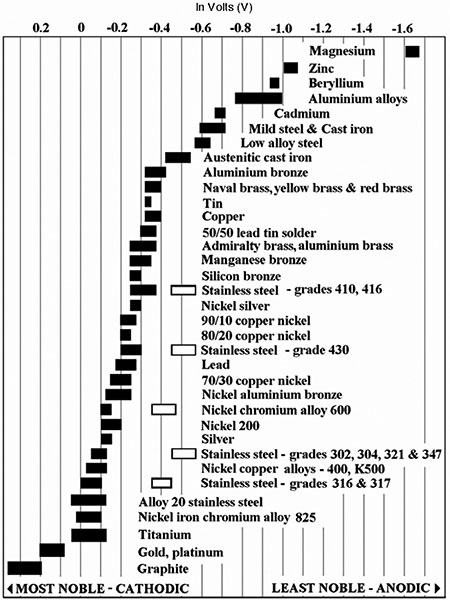
What are material selection considerations to avoid galvanic corrosion?
When galvanic corrosion is a concern, the chemical and physical properties of the material selected must be considered. However, this requires upfront information and knowledge; therefore, galvanic corrosion is an issue. If this is the case, then the user will need to replace or repair components at more frequent intervals.

Galvanic corrosion is the accelerated electrochemical corrosion produced when one metal is in electrical contact with another more noble metal, both being immersed in the same corroding medium (called the electrolyte). Corrosion of this type usually results in accelerated degradation for anodic and protection for the cathodic material. The cathodic material is the more noble metal.
With knowledge of the galvanic corrosion behavior of metals and alloys, it is possible to arrange them in a series that indicates their general tendencies to form galvanic cells and then predict the probable direction of the galvanic effects. The relative positions of the metals will vary to some extent depending on the electrolyte. Such a series for seawater is illustrated in Image 2.
When the liquid to be handled is an electrolyte, combinations of dissimilar metals that may promote galvanic reactions should, where practical, be avoided. The rate of corrosion, where metals widely separated in the galvanic series are used, will depend on such factors as the nature of the electrolyte, temperature, velocity and particularly the relative cathode-anode surface area.
Note that some of the metals in Image 2 are grouped together. These group members have no strong tendency to produce galvanic corrosion on each other. From a practical standpoint, they are relatively safe to use in contact with each other, but the coupling of two metals from different groups and distant from each other in the list will result in galvanic or accelerated corrosion of the one higher in the list. The farther apart the metals stand, the greater the galvanic action will be.
This may be determined by measurement of the electrical potential difference between them and this is often done. But it is not practical to tabulate these differences, because the voltage values for combinations of the metals will vary with every different corrosive condition. What actually determines galvanic effect is the quantity of current generated rather than the potential difference.
For more information on pump materials of construction and corrosion resistance, refer to “ANSI/HI 9.1-9.5 Pumps – General Guidelines for Materials, Sound Testing, and Decontamination of Returned Products” at www.pumps.org.

